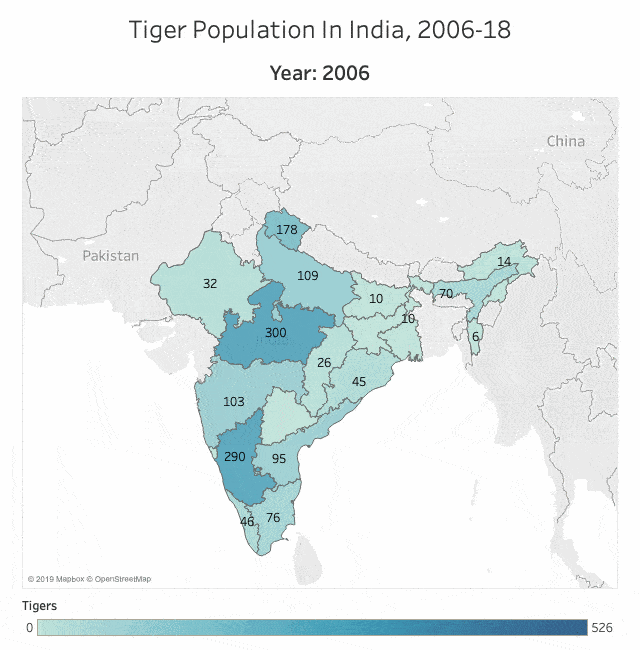India’s Tiger Population Doubles Over 12 Years. That’s Not All Good News

Mumbai: India’s tiger population more than doubled over 12 years to 2,967 in 2018, according to new data released by Prime Minister Narendra Modi on July 29, 2019. However, real success lies in managing the tiger’s geographical range and non-protected forests, experts said, which India does not do well.
The results of the just declared tiger census would make every Indian, every nature lover happy.
— PMO India (@PMOIndia) 29 July 2019
Nine long years ago, it was decided in St. Petersburg that the target of doubling the tiger population would be 2022. We in India completed this target four years early: PM
The new data are part of a government survey over 381,400 km of forested habitats across 20 states that are home to India’s tiger population, the world’s largest, as was the survey, according to the government.
“As far as the number is concerned, I don’t think we have achieved great success,” Raghu Chundawat, a conservation biologist who studies snow leopards and tigers, told IndiaSpend.
Real success would entail being able to manage the tiger’s geographical range, he said, adding, “If you read any conservation-related literature, one of the first signs of decline or extinction is range restriction, which is the geographical loss of the range distribution.”
Success would be when tigers occupy forests all over India as they did earlier, he said.
Tiger and other wildlife habitats invariably get short shrift when government decision-makers have to choose between wildlife considerations and infrastructure, mining or other industrial projects.
In May 2019, the Modi government exempted 13 railway projects from environmental approvals, even though four of the projects will fragment either a national park, tiger reserve, tiger corridor or wildlife sanctuary across Uttar Pradesh, Madhya Pradesh and Karnataka, IndiaSpend reported on July 27, 2019.
Over four years to May 2018, the ruling Bharatiya Janata Party-led government approved 519 infrastructure and industrial projects--many in violation of India’s environmental laws--in protected areas and “eco-sensitive zones” at nearly twice the rate that the previous government did, we reported in August 2018.
The Royal Bengal Tiger or Panthera tigris tigris, as the Indian sub-species is called, is an apex predator and its numbers ordinarily should reflect the health of India’s protected areas. But about a fourth of India’s tigers lived outside protected areas in 2015, a situation that may have worsened as protected areas were opened up further for infrastructure and industrial projects.
This is why experts are not impressed with the new numbers.
When Project Tiger was launched in 1973, there were nine tiger reserves (~18,278 sq km) which has now grown to 50 tiger reserves (~72,749 sq km), covering 2.2% of India’s geographical area, the report stated.
There has been an increase in the number of “protected areas” and “community reserves” across the country, Modi said at the launch of the report on July 29, 2019. Protected areas increased in number from 692 in 2014 to 860 in 2019, and community reserves to more than 100 from 43 in 2014, he said.
2014 में भारत में Protected Areas की संख्या 692 थी जो 2019 में बढ़कर अब 860 से ज्यादा हो गई है। साथ ही Community Reserve की संख्या भी साल 2014 के 43 से बढ़कर अब सौ से ज्यादा हो गई है।
— PMO India (@PMOIndia) 29 July 2019
As protected areas are invaded, the tiger has increasingly made human contact. A tiger was run over in Karnataka on July 27, 2019, another beaten to death on July 24, 2019 in Uttar Pradesh’s Pilibhit, and another was spotted jumping over a highway barrier in Maharashtra--the four-lane highway had expanded a road through the Pench tiger corridor.
This is at a time when conservationists warn that conservation cannot be limited to reserves.
“Managing the non-protected forests is the key,” Chundawat said. “If you want to take tiger conservation to the upper limit now you have to look outside [the protected areas]. Currently, we have the exclusive conservation model which is protected area-based. The moment the tiger goes outside, there is no jurisdiction to do anything about it. That is why lynching cases happen because we have not worked outside protected areas.”
To reverse the trend of extinction new conservation models that work outside protected areas are needed, Chundawat said. “Now the issue is that the tiger presence is only dependent on the goodwill of the people. Because it has to live with the people,” he said, “The current model only looks at the participation of the local communities outside the protected areas on a voluntary basis. There is no incentive [provided to them]. So there is a need to generate an incentive [to have] goodwill for the tiger.”
Madhya Pradesh has most tigers, up 71% since 2014
Madhya Pradesh reported the highest number of tigers, 526, or 18% of the number estimated in the country, followed by Karnataka (524) and Uttarakhand (442), according to the new survey, which used 2,461 photographs of individual tigers, comprising 83% of their population. The rest was “estimated using robust spatially explicit capture-recapture statistical models”, the survey said.
Tigers inhabit 13 countries--Bangladesh, Bhutan, Cambodia, China, India, Indonesia, Lao PDR, Malaysia, Myanmar, Nepal, Russia, Thailand and Vietnam. In 2010, these countries pledged to double the number of tigers by 2022, which is the Chinese ‘year of the tiger’.
Reaffirming commitment!
— Indian Diplomacy (@IndianDiplomacy) 29 July 2019
India has not only achieved its target of doubling the tiger population 4 years ahead of the scheduled time, but is now home to 75% of the world's tiger population.#InternationalTigerDay #GlobalTigerDay pic.twitter.com/kvRh5tWcJM
Indian tiger population up 6% per annum from 2006-18
Since 2006, India has conducted a countrywide tiger count every four years. This is the fourth such assessment of the tiger and its habitat.
India’s tiger population grew at a rate of 6% per annum when areas sampled consistently from 2006 to 2018 were compared, the report said. In the most recent period, India’s tiger population increased by 33% from 2,226 in 2014 to 2,967 in 2018.
Madhya Pradesh reported an increase of 71% from 308 tigers in 2014 to 526 in 2018, the most in the country. On the contrary, Chhattisgarh reported a 59% decline from 46 in 2014 to 19 in 2018. In Odisha, the tiger population--28 in number--seems to have remained constant over the four years to 2018.
“Protection and the areas made available for growth,” are the two things, Qamar Qureshi, senior scientist at Wildlife Institute of India, told IndiaSpend when asked about the performance of states such as Madhya Pradesh. The governments in Madhya Pradesh and Maharashtra are investing in removing villages [from the core and buffer areas], which has helped these states, he added.

Source: Status of Tigers in India 2018
Note:*Estimated through scat DNA; #For comparison with previous estimates of Andhra Pradesh, combine Andhra Pradesh and Telangana population estimate of current year. Figures for West Bengal include the tiger population of North West Bengal and Sunderbans
“The poor and continuing decline in tiger status in the states of Chhattisgarh and Odisha is a matter of concern,” the report stated. “Tiger occupancy has increased in the state of Madhya Pradesh and Andhra Pradesh. Loss in north-east is due to poor sampling.”
Of Chhattisgarh, Qureshi said: “The protection is poor and the areas we thought will improve they didn't.”
India’s tiger habitat in India is classified into five landscapes--Shivalik hills and Gangetic plains, central and eastern ghats, western ghats, north-east hills and Brahmaputra, and the Sundarbans.
The central and eastern ghats landscape, comprising of eight states--Andhra Pradesh, Telangana, Chhattisgarh, Jharkhand, Madhya Pradesh, Maharashtra, Odisha and Rajasthan--with 35% of India’s tiger population, reported the highest increase of 50% from 688 in 2014 to 1,033 in 2019.
The north-east hills and Brahmaputra reported a 9% increase from 201 in 2014 to 219 in 2018. The Sunderbans reported an increase of 16% from 76 to 88 over the same period.
No tigers were spotted in Buxa in West Bengal, Dampa in Mizoram and Palamau in Jharkhand tiger reserves, the report said. These “reserves had poor tiger status in earlier assessments as well”.
657 tigers died in 7 years to 2018, 21% due to poaching
Between 2012 and 2018, 657 tiger deaths were reported in India, most of them (48% or 313) due to natural causes and 21% or 138 due to poaching, official data from the National Tiger Conservation Authority show.
Of the 138 poaching deaths, Madhya Pradesh reported the most (22% or 30), followed by Karnataka (24) and Maharashtra (18).
“The market for poaching has not disappeared and is very much alive,” Qureshi said. We have to ensure that the protection level is maintained or will be improved. “Now that the WHO [World Health Organization] has also recognised the traditional medicine in China, it is a big threat for many of these species which are in the trade.”
The Bengal tigers could vanish from the Bangladesh Sundarbans within the next 50 years--by 2070--as a combination of climate change and rising sea levels threatens their last remaining habitats, according to a study published in the journal Science of the Total Environment, as IndiaSpend reported on March 12, 2019. The effects of climate change are expected to affect the Indian Sundarbans in a similar way.
There are around 3,900 tigers worldwide, according to World Wildlife Fund, as of April 2016. The world has lost 95% of its tiger population since the beginning of the 20th century.
The decline is attributed to illegal trade in tiger parts, hunting and habitat loss. Three of the eight tiger sub-species have already become extinct, with the remaining five either ‘endangered’ or ‘critically endangered’, as IndiaSpend reported in March 2019.
(Mallapur is a senior policy analyst with IndiaSpend.)
We welcome feedback. Please write to respond@indiaspend.org. We reserve the right to edit responses for language and grammar.


